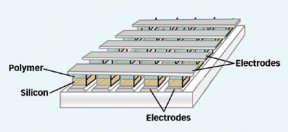- More than 2 years ago
In their quest for alternatives to silicon, chip manufacturers are increasingly turning their attention to plastic. Low-cost, easily manufactured polymers that conduct electricity could revolutionize electronics, they say. Now, researchers at Princeton University and Hewlett-Packard Laboratories in Palo Alto, Calif., have fabricated a polymer-based memory device for permanent data storage.

In the new scheme, a single memory cell consists of a layer of polymer sandwiched between a gold electrode and an aluminum one. In the polymer’s original state, positive charges carry current through the material. To encode data in a cell, the researchers apply a voltage, which injects electrons into the polymer. Positive charges from the gold electrode then flood the material to neutralize the electrons.
The movement of charge, which occurs in about a microsecond, permanently switches the polymer from a conducting to a nonconducting state–or from a 0 to a 1, in computer terminology. Says lead investigator Stephen Forrest of Princeton, “It looks like the same material, but something internally has changed quite dramatically . . . and it’s very stable.”
To read each cell, the researchers apply a smaller voltage. With the help of a silicon diode that electrically isolates the cell from nearby ones, they then measure the current flowing through the cell. The scientists describe their new plastic memory in the Nov. 13 Nature.
Forrest anticipates that an array of polymer memory cells on a 1-millimeter-square chip could store 1 megabit of information. Because the data are permanently inscribed, such polymer memory devices would be well-suited for storing archival materials, digital photos, and video. Although other media, such as the magnetic material in a hard drive, can store more data (SN: 9/13/03, p. 171: Available to subscribers at Memory Enhancers), plastic devices are less expensive and require less energy to operate, says Forrest.
And there’s room for improvement, he notes. In the new plastic device, each cell measures 17 square microns. However, Forrest predicts that his team could get that dimension down to just a couple hundred nanometers. What’s more, he says, “you can stack the devices on top of each other.” To demonstrate that, he has created a 1-centimeter-cube model device that, in theory, could store 10 gigabits of data, or about double the amount on a CD-ROM.
In the future, a small, cube-shaped device such as this one could sit in a digital camera and permanently store thousands of photos, Forrest says.
“It’s a brilliant approach,” says Vladimir Bulovic, an electrical engineer at the Massachusetts Institute of Technology. However, MIT chemist Tim Swager cautions that because the underlying mechanism remains unclear, he’s unconvinced that the voltage-induced switching is permanent.
The new work falls in line with the worldwide effort to develop polymer memory devices for applications including rewritable chips, such as the short-term memory on a computer. “That’s a much harder task,” says Bulovic.
****************
If you have a comment on this article that you would like considered for publication in Science News, send it to editors@sciencenews.org. Please include your name and location.





